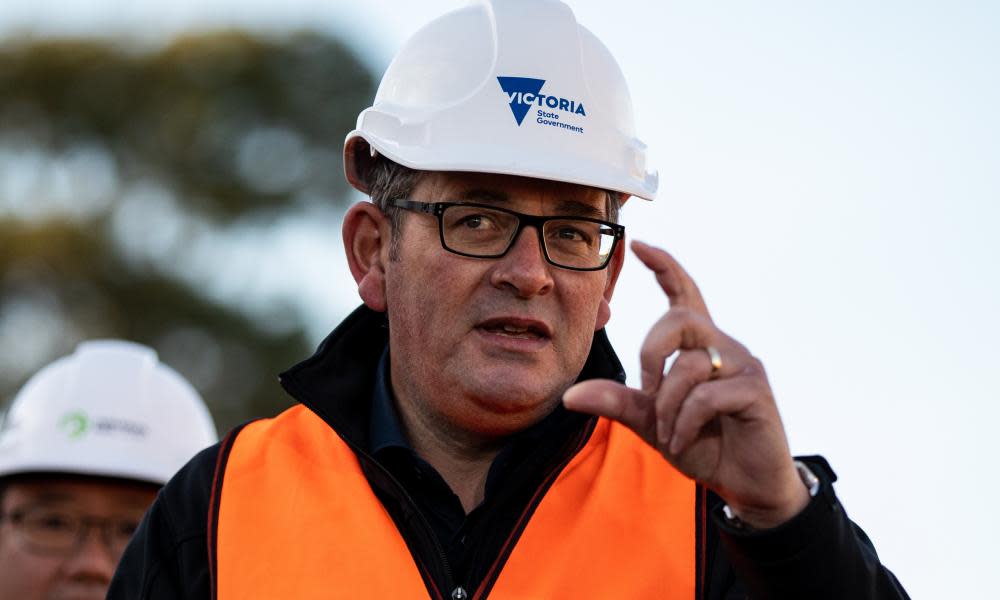Explainer: how much money would shelving the suburban rail loop save Victoria?

The suburban rail loop is set to become one of the big talking points of the Victorian state election campaign after the opposition leader, Matthew Guy, said he would shelve stage one in favour of spending on health.
Here’s everything you need to know about the project.
When was the suburban rail loop first announced?
The project was announced in August 2018, just months out from the previous state election, via a slick two-minute video posted on Andrews’ social media.
“The biggest public transport project in history is coming to Victoria,” the voiceover said, before unveiling a proposed 90km underground railway line, running between Cheltenham in the south-east and Werribee in the south-west via Melbourne airport.
The video said the new line would carry 400,000 passengers a day when complete, taking 200,000 cars off the road and thousands of commuters off existing city-bound trains.
Related: Matthew Guy pledges to shelve $34.5bn rail project to invest in healthcare
At the time, Andrews said the government would commit $300m to a full business case, design and pre-construction works for the project.
“I won’t be the premier when this project is finished, but if we are re-elected, I will be the premier that gets this project started,” he said in 2018.
The government went on to win in a landslide, with an above-average swing to Labor in electorates set to benefit from the loop. Three of the eight seats Labor picked up at the election – Box Hill, Burwood and Mount Waverley – had new stations promised.
Where is the project at?
In November 2020, Andrews announced $2.2bn for early works for the first 26km of the project, dubbed SRL East, as well as the location of the six stations between Cheltenham and Box Hill.
Last year, the government released its business and investment case for SRL East and SRL North, which runs from Box Hill to Melbourne airport.
At the time, it was estimated SRL East would cost up to $34.5bn to be completed by 2035. The business case did not detail plans for the western section of the loop, between Melbourne airport and Werribee.
In November 2021, the government announced a further $9.3bn for SRL East and awarded the contract for the first phase of works to global construction and engineering firm Laing O’Rourke.
The firm has since established its first work site at Clayton, and expressions of interest are now open for two tunnelling packages, to be awarded in late 2023 and 2024.
In August 2020, after an independent inquiry, Victoria’s environment minister, Lily D’Ambrosio, found the environmental effects of the project acceptable.
Construction for the project began in June.
How will the project be funded?
A mixture of commonwealth, state government funds, private investment and value capture is behind the project.
Ahead of the federal election in May, Anthony Albanese committed $2.2bn for the eastern section.
The Victorian government is seeking a further $9.3bn in federal funding and at least $10bn from the private sector.
How much extra money would the Coalition plan free up?
The Coalition has pledged to shelve the $34.5bn first stage of the suburban rail loop and re-divert allocated funds into repairing the state’s burdened health system.
Related: Myki: how Melbourne’s transport card went from Australia’s envy to also-ran
While Guy has pledged to “reprioritise every single cent” of funding from the first stage, the state government’s budget papers show the Victorian government’s contribution to the first stage is $11.8bn.
Guy has committed to not tearing up $2.2bn worth of early contract works already signed, in a bid to avoid replicating the Andrews government’s tearing up of the East-West Link which exceeded $1.1bn.
This leaves, at most, $9.6bn of additional funds to be freed up for the health system.
The Andrews government said the shelving would slash 24,000 jobs connected to the project. But the opposition has argued more jobs would be created through upgrading the state’s health system.
Pressed on if the project would ever be built, Guy said: “When the state can afford it, we might be able to build it.”

 Yahoo News
Yahoo News 
